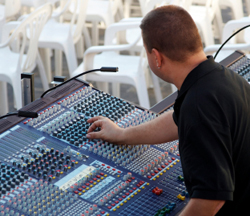
Big rooms often have resonances based on room dimensions – if the ASE can determine the problem frequencies ,and notch two or three of these out of the response, the bottom end tends to clean up, usually leading to everything sounding better.
Reflections can also be a problem. Many times a scoreboard will be in exactly the wrong place for a sound system. The first move of a traveling ASE is often to talk with venue management to get a scoreboard trimmed out of the way as much as possible.
There are various workarounds to this dilemma as well, such as deactivating compression drivers impacted by the scoreboard, along with deploying loudspeakers on delay to bolster coverage to affected regions.
A good alternative is carrying a small curtain truss to mask this object. A couple of chain motors and some 12-inch truss with soft goods is not a high price to pay for successful audio performance. Your clients will appreciate the attention to detail.
Doing Homework
Today’s ASE must be well educated about the various electronic components scattered throughout a sound system. Either acquire and carry manuals for all pieces, or make other arrangements to have access to this information.
Many manuals are now available in PDF format, and an average computer can carry thousands of these files without a problem. Most are also posted on-line at manufacturer web sites. Some manuals are good, some not so hot, but even a little information is always better than none.
An ASE also uses downtime to do homework, being diligent in learning as much about every piece of gear prior to a gig and/or going on tour. The time for questions is as soon as possible, not an hour before show time.
While an ASE should be able to solder and make minor equipment repairs, it’s difficult to become a truly qualified repairperson. In my view, it’s far more important to have a work-around for failing components than it is to diagnose and repair them on site.
Besides, having spare components in the racks is standard operating procedure for all good sound providers. Be sure these spares are indeed included before hitting the road, and further, they should be ready to use by having an assortment of interface options and the necessary tools to circumvent the defective equipment in short order.
The Point
There you have it. Only there’s so much more to being an ASE that’s of true service and benefit to everyone else involved with a production.
I’ve covered a lot of ground here, in general and rather large swaths. My point is to make a point: this is serious work, there is a lot to know, every show is different and one must be able to adapt to survive.
But the underlying message is that this work goes beyond trivial job titles and patronizing slaps on the back that may or may not even be deserved. In it’s most distilled form, this is work about working diligently to live up to the definition of a true professional.
Dan Laveglia has worked as an ASE for more than 30 years, working with a wide variety of tours, larger and smaller.
